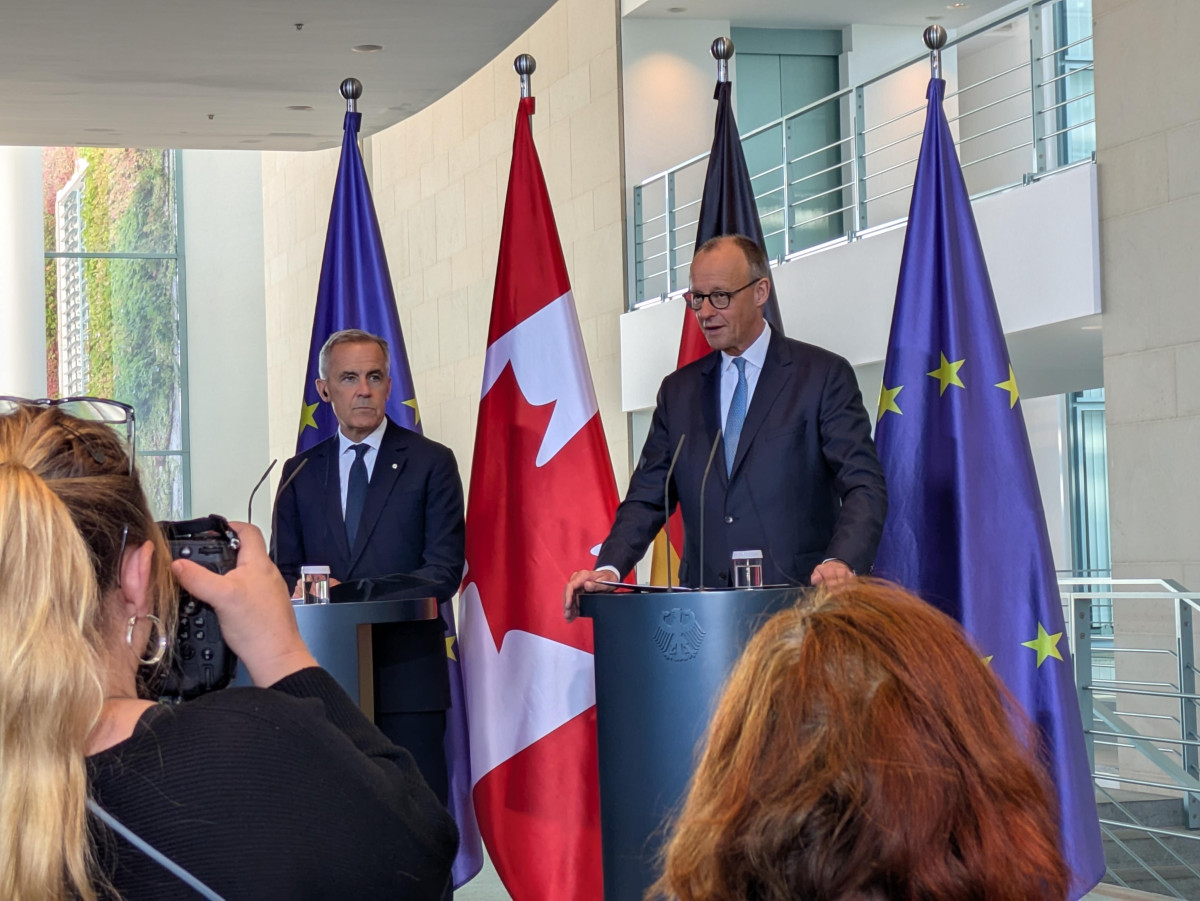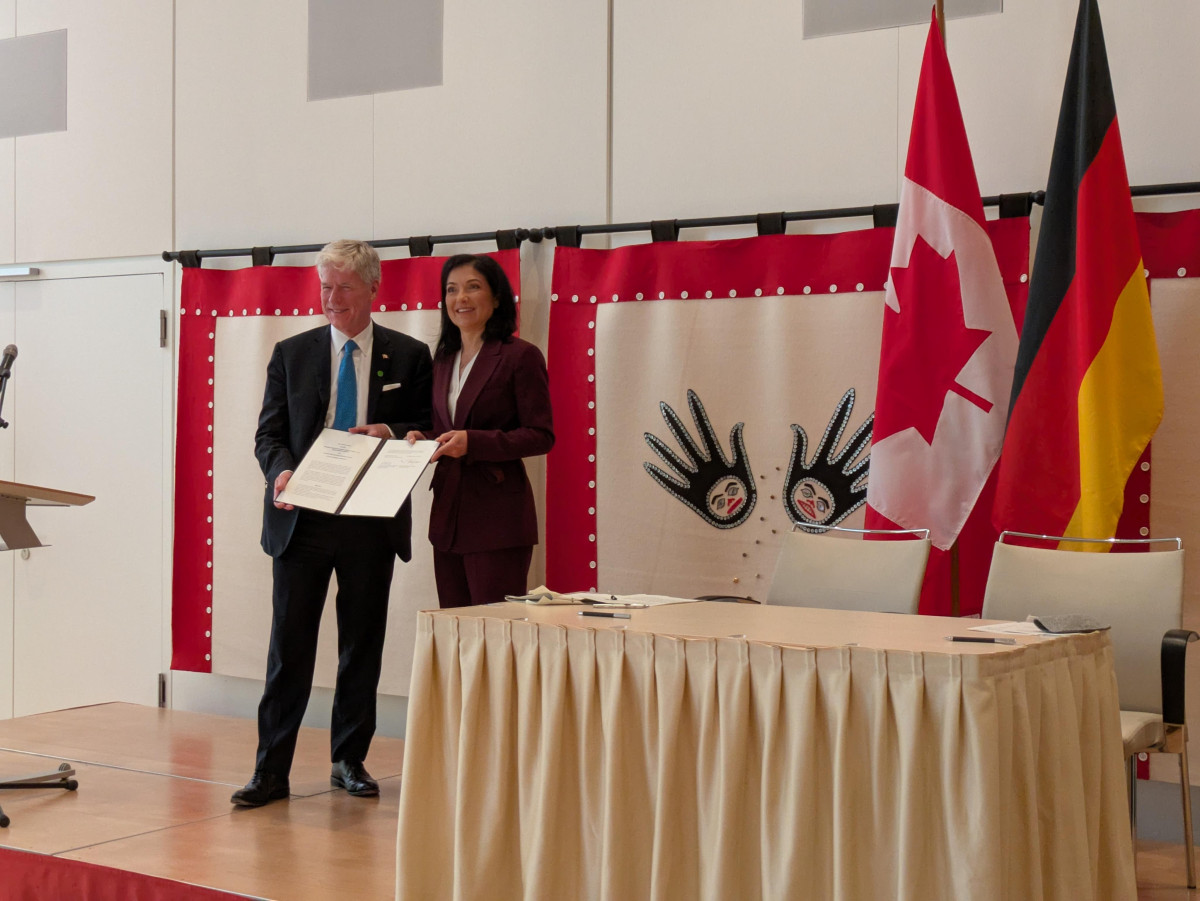Canada ready to fuel Europe's gas, hydrogen and mineral needs
[For a take from Canada, read this article on The Energy Mix.]
Canada's government is gearing up to expand infrastructure that would allow energy and critical mineral deliveries to Europe, said prime minister Mark Carney during a visit to Germany’s capital Berlin.
“The number one focus of this government is to build that infrastructure, and particularly infrastructure that helps us deepen our partnership with our European partners and particularly Germany,” said Carney during a press conference with German chancellor Friedrich Merz on 26 August.
Asked about what Canada could realistically offer to Europe, given that ports on the East Coast and pipelines are still lacking, Carney said: “There is a huge range of immediate opportunities with respect to critical metals and minerals, and there are medium term opportunities with respect to all forms of energy, including LNG and hydrogen.”
Canada is once again open for business. [...] Germany’s competitiveness depends on reliable, affordable energy. Your chemical plants, your steel mills, automakers, all need secure supplies of energy. Canada Can help. We are uniquely positioned to be both a conventional and clean energy superpower.
LNG export infrastructure on Canada’s East Coast?
Canada has considered the option of supplying Europe with liquefied natural gas (LNG) for some time, but plans for export terminals on the East Coast have not materialised yet, largely due to the need for massive new port and pipeline infrastructure to transport the fuel to the coast, liquefy it and ship it to Europe. The country just opened an LNG export terminal on its west coast, well-placed to deliver fossil gas to countries in Asia.
Carney said that his government was “in the process of unleashing half a trillion dollars of investment” in energy, port and intelligence infrastructure. The first such investment would be formally announced in the next two weeks, said Carney without providing details. He added that investment examples in the public domain include “reinforcing the port of Montreal, Contrecoeur, a new port, effectively, in Churchill, Manitoba, which would open up enormous LNG plus other opportunities, and other east coast ports for those critical minerals.”
Canada’s energy and natural resources minister Tim Hodgson also travelled to Berlin and together with German economy minister Katherina Reiche facilitated talks between businesses from both sides of the Atlantic.
“We had very good discussions on Germany's interest in Canadian liquefied natural gas and on continuing the development of ammonia and hydrogen supplies from Canada to Europe,” Hodgson told a press huddle afterwards. Asked whether Canada’s government would help finance any projects, Hodgson said that there were tools it could use, such as the Canada Infrastructure Bank or the Canada Growth fund. “The government is going to use all the tools it has to responsibly develop projects, to do it in a way that's responsible for Canadian taxpayers and do it in the right environmental way, and in conjunction with First Nations,” he said.
A day later, at an event with business representatives from both countries, Hodgson doubled down on the offer to Germany.
“Canada is once again open for business. Nowhere is this more important than in the energy sector. Germany’s competitiveness depends on reliable, affordable energy. Your chemical plants, your steel mills, automakers, all need secure supplies of energy. Canada Can help. We are uniquely positioned to be both a conventional and clean energy superpower. We have abundant natural gas reserves, top-tier LNG projects, vast renewable resources, strong hydrocarbon potential, a first-class nuclear industry and world-class carbon capture expertise.”
Hodgson emphasised that his government had "opened the doors" to LNG exports. “If the demand is here and the infrastructure is built, Canada will deliver," he said.
Greater gas demand in Germany for longer time period – Canada’s energy minister
Analysts doubt Canada could deliver any time soon. "We currently see no specific projects on the Atlantic coast that are in the start-up or investment phase," said Andreas Schröder, head of gas analytics at ICIS. Projects like Goldboro LNG and Atlantic Coast had either already been abandoned or were not sufficiently advanced. "It is therefore difficult to imagine that Canada will be able to meet Germany's wishes in the short term, but rather only after 2030. LNG export terminals are technically very complex projects with long lead times and high financial volumes," he said.
The German Gas and Hydrogen Industry association still welcomed Canada's bid. "In these times, it is a very important offer, which could help us gain another partner for the diversification of our energy supply," said the group's chairman Timm Kehler. "I hope that our stakeholders will also take advantage of this opportunity," he told Clean Energy Wire. German industry needed affordable gas, and long-term contracts were “the right way.”
How much demand there will be for Canadian gas from Germany and the EU remains uncertain. Europe sought to find new suppliers following the halt of gas supplies from Russia in the aftermath of the war against Ukraine. Russia was the main supplier of oil and gas to Europe, and Germany only received it through pipelines. The war and the energy crisis pushed Germany to build domestic LNG import terminals to help diversify supply. The first temporary import terminal was inaugurated at the end of 2022. The US has filled some of the gap left open by lacking Russian supply through LNG deliveries from its Gulf Coast, and it continues to expand its export infrastructure.
However, Europe is also aiming to become climate neutral by 2050 – Germany already by 2045 – and will have to largely phase out the fossil fuel by then. Even German government officials have warned that Europe's appetite for natural gas is set to shrink. Overall demand is projected to decline over the coming years and especially decades, increasing the risk of stranded assets in case of new gas infrastructure.
"In the medium and long term we're not anticipating an increase in gas demand, certainly not in Western Europe," Pawel Czyzak, Europe Programme Director at think tank Ember told The Energy Mix. "In fact, even typically conservative gas and electricity grid operators are not anticipating a rise in gas demand, which means Europe is already heavily oversupplied towards 2030. That oversupply will get even more severe if the questionable fossil fuel imports from the EU-US trade are implemented," he said.
Gas use in Germany in particular is also projected to decline, although this could happen at a slower rate than projected until now. Lagging electrification of sectors like buildings mean that households are set to use gas heaters for longer. In addition, the country’s industry also struggles to decarbonise and will require gas as feedstock and to generate heat in production for some time.
Only 15 to 20 percent of the gas Germany consumes is used for electricity production. While the country is currently planning to expand its gas-fired power plant capacity, the new plants would mainly run at times of low wind and solar power feed-in. Overall gas use in the sector is also projected to decline as Germany continues to build out renewables.
Still, Canada’s Hodgson said German businesses had signalled interest. “There seems to be a desire on the part of Germany to buy our natural gas, and we have a desire from proponents, a province, and First Nations to develop that for German customers,” he said.
The minister explained that until a few years ago, there was a view that the need for natural gas would be relatively minor and there only for a relative short term. “What we all realise post the Ukraine, post what is happening with AI, is that natural gas is going to be a transition fuel that is in greater demand in Germany and for a longer period of time,” he told journalists. Canada had the opportunity to be a “great partner” to Germany in that regard.
Hodgson said Canada is currently producing “the lowest-carbon-footprint natural gas of any country in the world,” because it used clean energy for liquefaction.
Canada ready to export in time for global gas glut?
However, time could be of the essence for Canada’s oil and gas sector. Not only is European demand projected to decline, but the world might be heading for a glut of supply. Researchers have warned of the dangers of vulnerable new gas projects in Canada.
How fast could new infrastructure be up and running? Minister Hodgson said that proponents were talking about building pipeline and harbour infrastructure to be able to have the first shipment in “as little as five years.” It remains to be seen whether such an optimistic scenario faces significant delays due to domestic opposition to infrastructure projects across the country. Hodgson said that Canada would build any new infrastructure “in an environmentally responsible way.”
Canada is also thinking beyond a time when gas plays the main role in energy exports to Europe.
“Canadian hydrogen will support your transition to clean energy, and away from relying on Russia or other unreliable sources,” he said. This would be produced in low-emission facilities on Canada’s East Coast, “less than 3,000 nautical miles away from docking at German ports.”
Gas lobbyist Kehler welcomed this. As Germany was moving toward climate neutrality, it was important to find “partners which actively shape the transition from grey to green molecules” and Canada could fill those shoes, he said.
Critical minerals cooperation
Germany and Canada also signed a joint declaration of intent on cooperation on critical minerals. The two countries aim to push for the diversification of supplies of critical minerals, which are increasingly important in products needed for defence, the energy transition, and clean technologies. A major objective would be to promote and strengthen cooperation and trade in the critical minerals value chain, with a focus on midstream technologies, including mineral processing, refining, and recycling, said the declaration.
“On rare earths, Canada is in a position to develop the only mine-to-magnets complete supply chain outside of China in the world,” said minister Hodgson. That is an incredibly important thing from a sovereignty and security perspective.
Stable and reliable supply chains are of central importance to companies in both countries, said German economy minister Reiche. “The supply of critical raw materials in particular is key to the competitiveness of our economy.” As part of the signing between Germany and Canada, three memoranda of understanding on cooperation in the field of raw material extraction and processing between German and Canadian companies were also signed (between Vaccuumschmelze and Torngat Metals, Enetrag and Rock Tech Lithium, and Aurubis and Troilus Gold).



